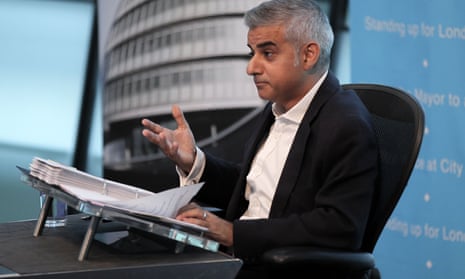Bit by bit, Sadiq Khan’s formula for changing London’s housing landscape is coming into view. A little more was sketched in on Wednesday. Answering questions from Labour AM Tom Copley about his long-term goal of making 50% of all new homes in London “genuinely affordable”, Khan, as is now his habit, warned that “we won’t fix the housing crisis overnight” but went on: “I’m going to raise the level of affordable housing by using my planning powers alongside investing the funding available and the release of public land. In terms of planning, my team are currently developing supplementary planning guidance – SPG – to increase the numbers of affordable homes delivered through the planning system.”
We’ve already seen him exercise those planning powers. Last month, Khan approved plans for the first large housing development on the vast Old Oak and Park Royal site in west London after the number of “affordable” homes was bumped up from 200 to 242 – from 33% of the total of 605 to 40%, with the possibility of raising that to 50% if sufficient profits are produced in the future. More recently, to the east, he approved the masterplan for the huge Barking Riverside regeneration after the “affordable” proportion of the possible 10,000 new homes there was upped from 28% to 35%. Provision for a possible subsequent hike to 50% is built in there too.
Those were substantial tweaks to big bits of London housing arithmetic that had been lined up for a big tick from Boris Johnson. But it’s the draft SPG, expected in October, that will formally set the tone of the new mayoral administration on housing delivery. Khan explained that it has to be written “within the context of the policies in the current London Plan”, the legally-binding master policy blueprint for the development of the capital’s land. He intends to change the Plan, but acknowledged he’ll be bound by the present version “for the foreseeable future”, which could mean three years - that’s how long it took Johnson to produce a replacement for Ken Livingstone’s.
Khan said that this constraint means “I cannot set a target for affordable housing”. This might come as a surprise - there have been reports that a 35% affordable “benchmark” for all new private housing schemes could be included in the SPG. But a target and a benchmark are not the same. Khan said that in drafting the SPG he was “exploring an innovative new approach, whereby if applicants voluntarily meet an agreed level of affordable housing, they could benefit from a faster and more certain planning process”.
He stressed that “this level has not been finalized or announced”, though 35% seems unlikely to be far wide of the mark. But the operative word in all of this seems to be “voluntarily”. SPGs do not (and cannot) introduce new planning policies, but they serve to elaborate on or sharpen existing ones.
The current London Plan policy on affordable housing requires only the “maximum reasonable” to be supplied as part of each individual private development. Khan is hoping to incentivise developers to maximise what they deem “reasonable” by effectively telling them that if they are prepared to meet the affordable level he sets down in the SPG, he will help to speed them on their way.
Copley asked if this therefore meant that developers who didn’t accept the “affordable” housing levels he had in mind would find their assessments of a scheme’s financial viability coming under close scrutiny from him. Khan’s response? “Not an unfair summary of where we’re going”. A team of viability boffins is being recruited for such tasks.
City Hall later elaborated: “Developers may opt to meet new minimum affordable housing thresholds to fast-track their applications”. So for “benchmark” read “thresholds” (the plural may or may not be significant. I’m told there’s still a bit of a fine-tuning to be done).
The other angle on all this is that Khan’s affordable levels/thresholds are being designed to bring more clarity, speed and consistency to the planning application process. Recent controversies over viability assessments - in Earls Court and Southwark, for example - have centred on concerns that well-resourced developers get the better of boroughs in negotiations over the amount of affordable housing they supply as part of the deal. Yet some developers say that they could do without the grief viability wrangles entail. So there’s a trade-off to be proffered brewing here: in return for higher affordable yields Khan will provide a more straightforward planning environment and preferential treatment for the obliging.
There is a long way to go before that 50% goal starts to be met. For example, Khan confirmed to Copley that doing so is going to mean hitting more than 50% affordable on publicly-owned land, such as TfL’s - no small task. But be glad. What we’re seeing the start of in Khan’s City Hall is a more rigorous approach to property market regulation, which is what planning policy is for. His Tory critics warn that it can only make things worse, but Khan hopes he’s got the key players onside. Their responses to the SPG will be enlightening.

Comments (…)
Sign in or create your Guardian account to join the discussion